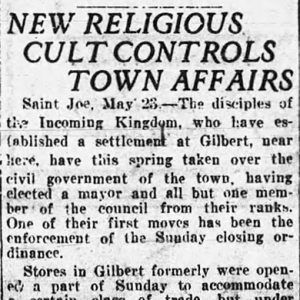calsfoundation@cals.org
Incoming Kingdom Missionary Unit
One of Arkansas’s quirkiest religious groups, the Incoming Kingdom Missionary Unit, located at Gilbert (Searcy County), was founded shortly after World War I. A Midwestern clergyman, the Reverend John Adams Battenfield (1876–1952), taught that the world would end “shortly” amid “a great world-wide war between Catholics and Protestants.”Therefore, the faithful, those who heeded Rev. Battenfield’s message, needed to prepare for this impending event by fleeing their present communities and establishing themselves in completely self-sufficient communities, or “Kingdom Units,” in scattered remote mountain areas across the nation. From here, they would emerge after the holocaust and establish the Millennial Kingdom of God. In each community, all property was to be communally owned, government was to be in the hands of the church elders, and those who refused to work (“shirkers”) faced eviction from the community. All members would also learn Hebrew, the language of the incoming kingdom. Because of its remoteness in the Ozark Mountains, Gilbert was chosen as the location of one of these units.
Rev. Battenfield was born in Napoleon, Ohio, on September 8, 1876. He became fascinated with religion, especially with Bible prophecy, at an early age; by fourteen, he had memorized the book of Revelation and, by sixteen, was already preaching. Before he was twenty, he was ordained as a minister in the Christian Church (Disciples of Christ). Soon after beginning his formal ministry, he claimed to have discovered within the Hebrew text of the Old Testament “patterns of sevens” that provided him with an infallible technique for distinguishing its “true readings from interpolations.” Shortly before the beginning of World War I in Europe, he published the first of a series of pamphlets called “The Great Demonstration” announcing that the world as it existed would end soon, perhaps in 1923.
About the same time, he left his denomination’s formal ministry and became a traveling religious lecturer on a divinely appointed mission to prepare the world for this great, apocalyptic event. In 1919, the first issue of his defining religious newspaper, the Incoming Kingdom Harbinger, was published in Olney, Illinois. However, after initial acceptance from denomination leaders, his extremely complex theology and his speculations concerning the imminent end of the age soon met with increasing skepticism. Eventually, his views were denounced as “weighed in the balances and found wanting.”
Battenfield, believing that he had a divinely appointed mission, proceeded with plans to build his “economic self-sufficient colonies” across the country, with Gilbert as the first. Subsequent colonies were established in Elkton, Oregon, and Buffalo Ridge, Virginia. His movement attracted followers from urban and rural working classes, many of whom were dissatisfied with established churches. The Gilbert Kingdom Unit was launched in September 1920 when C. E. Jordan, a wealthy Illinois farmer and a firm believer in Battenfield’s vision, bought land at the site and divided it into lots for the incoming “colonists.” Within a few months, seventy people made their homes in the community. A church, schoolhouse, and printing plant were quickly built. The Incoming Kingdom Harbinger was printed and mailed out nationwide from Gilbert. The new citizens of Gilbert also began mission outreaches in the nearby communities of Bruno (Marion County), St. Joe (Searcy County), and Witts Springs (Searcy County). A cooperative store was opened at Bruno, and a manufacturing cooperative, Water Creek Christian Industries, was organized at Maumee (Searcy County). However, all of these efforts were short lived.
Battenfield’s utopian vision soon ran afoul of the individuality of his colonists, with many of his followers reluctant to share their possessions or resources freely with others. Other problems arose when Battenfield began to abandon traditional Christian teachings on the Trinity and other subjects. The year of 1923 passed without the appearance of the Messiah and his kingdom. In 1925, after several failed public attempts to bring a deceased parishioner back to life, Battenfield suffered a nervous breakdown. His publication was immediately suspended, and he and his family left Gilbert. Shortly afterward, his remaining Gilbert followers renounced his prophesies and teachings.
By 1930, Battenfield and his family were living in Olney, Illinois, where he was again pastoring Christian Churches. He died in Holmes County, Ohio, on January 3, 1952.
For additional information:
Gilmore, Robert. “People and Places in Buffalo River Country.” OzarkWatch 8.4 (1995). Online at http://thelibrary.springfield.missouri.org/lochist/periodicals/ozarkswatch/ow804g.htm (accessed January 24, 2022).
Heuston, John. “Gilbert, a Utopian Experiment.” http://www.northark.com/gilbert/History.htm (accessed January 24, 2022).
Reverend John Adams Battenfield File. Disciples of Christ Historical Society, Nashville, Tennessee.
Thompson, Doris. “History of an Ozark Utopia.” Arkansas Historical Quarterly 14 (Winter 1955): 359–373.
Russell P. Baker
Mabelvale, Arkansas
 Gilbert Takeover
Gilbert Takeover  Incoming Kingdom Article
Incoming Kingdom Article  Message from Cult Leader
Message from Cult Leader 



Comments
No comments on this entry yet.